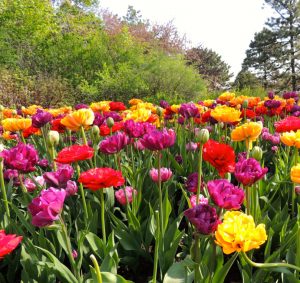Worth the wait
by Julianne Labreche
If you like instant gratification, do not plant bulbs. They will not bring you pleasure. The plain truth is it takes a certain kind of person — someone with stoic self-restraint and an abundance of patience — to don gloves and head out on a chilly fall day to plant bulbs. Once they’re planted, you’ll walk away from them for at least six months. You’ll wait and wait some more as those bulbs rest in the cold soil, covered in ice and snow.
Then, one morning in spring, you’ll awake to the beauty of bulbs. For the patient person, it will be well worth the wait. How glorious it is to see those blazing reds, hot pinks, showy yellows and cool blues after so many months of grey skies and dirty snow. First come the dainty snowdrops and cheery crocus. Next come the big, bold tulips and sunny daffodils. Then out pop the purple and white alliums, a feast for hungry bees.
While my patience for housework is limited, my patience for garden work is infinite. As a dedicated gardener, I love bulbs for several reasons. Not only are they beautiful in bloom but incredibly simple to plant. Honestly, it just doesn’t get easier: dig a hole in well-drained soil, pop in those bulbs, cover with soil, water once and then let nature take its course. Well, on second thought, there are some other things to know. Here are some helpful tips:

Buy the best bulbs — No matter the kind, don’t skimp on size or price. Buy large firm ones. Bag your own, selecting them individually if you can. That way, you can examine them for size and strength. Pass over any with blemishes or softness but don’t be concerned if the papery bits fall off.
Select the right spot — No matter the species, most bulbs like a sunny location. I learned that by error years ago when I planted a few tulip bulbs in shade too close to the house. To this day, those spunky pink tulips try to stretch to the sun then flop and fade. Most bulbs will be unhappy if planted too close to evergreens with their year-round shade and acidic, often dry soil. Woodland bulbs will successfully burst into bloom in partial shade when planted under deciduous trees that bud later. Bulbs that spread and naturalize look pretty when planted this way.
Plant to the right depth — Read any instructions that come with your bulbs. Remember to plant the pointy side facing upward. Generally, you will be digging a hole about three or four times the height of the bulb. Tulip and daffodil bulbs, for instance, should be planted between 15 and 20 cm deep and seven and a half to 20 cm apart. Smaller bulbs such as crocus and snowdrops should be planted at a shallower depth, about five to 10 cm deep and five centimetres apart.
Plant in clumps — Flowering bulbs planted alone look, well, lonely. Plant in groups of five, seven or nine. Planting is simpler if you dig one larger hole rather than individual ones. The exception is naturalized bulbs, usually placed by throwing handfuls of them around a focal point in the garden and then planting them where they land. Avoid planting in straight lines; nature likes curves. Gradually, bulbs reproduce and spread. Many bulbs will multiply and may, in time, need to be dug up, separated and replanted.
 Timing is everything — Spring-flowering bulbs always are planted in fall. Plant hyacinth and daffodil before Thanksgiving as the bulbs will need time to root and get established. Tulips can be planted later in fall, providing the soil is still workable.
Timing is everything — Spring-flowering bulbs always are planted in fall. Plant hyacinth and daffodil before Thanksgiving as the bulbs will need time to root and get established. Tulips can be planted later in fall, providing the soil is still workable.
Be wary of critters — Ah, the squirrels. Love them or hate them, they have an appetite for some kinds of bulbs, including crocus and tulips. I always cover these bulbs after planting with old wooden planks that are removed once the ground freezes. Some gardeners prefer to use chicken wire. One easy solution is to plant daffodils instead. They are toxic, and the squirrels are smart enough to leave them alone. In spring, critters get thirsty too, so I provide fresh water at ground level to give them an alternative to munching on juicy stems.
Plant for continuous bloom — Succession planting using early, mid and late flowering bulbs will ensure continuous joy throughout the spring season. Check on flowering times before you buy bulbs.
Leave foliage after flowering — After blooming, deadhead spent flower heads but leave the foliage alone. As the leaves die back, nutrients are stored in the bulbs for next season. Wait until the leaves are yellow and straw-like and can be removed with just a tug. Remove them too soon and blooms may be smaller next year. The fading foliage is not pretty — that’s why I always plant my bulbs in my daylily bed. As daylilies grow, they hide the mess.
That’s likely everything that you need to know about growing fall bulbs. If you’re a patient person, these tips should be useful. If not, then save your hard-earned dollars. Come spring, buy a few pots of blooming tulips and plant them up. No one will ever know. It will be our little secret.

Good bulbs to naturalize
Who doesn’t love spring flowering bulbs? Crowds at The Canadian Tulip Festival are proof of the popularity of bulbs. Many of our Canadian bulbs are imported from the Netherlands, including the tulips donated by the Dutch government annually for this festival. If you’re looking for bulbs that spread and naturalize, try these:
‘King Alfred Daffodil’ (Narcissus King Alfred strain) — These large, showy yellow flowers are easy to grow in full sun or part shade.
‘Queen of the Night’ Tulip (Tulipa ‘Queen of the Night’) — Tall, reliable tulips in shades of deep purple or almost black add a touch of drama to any garden.
‘Blushing Beauty’ Tulip (T. ‘Blushing Beauty’) — This delicate late spring tulip in shades of pinks and lilacs is tough. The stems will withstand rain and wind.
‘Pickwick’ Crocus (Crocus vernus ‘Pickwick’) — An early spring bloomer with vivid blue and white striped blooms.
Glory-of-the Snow (Chionodoxa luciliae) — Small blue flowers that look striking when planted in a rock garden or under a tree.
Armenian Grape Hyacinth (Muscari armeniacum) — A royal blue and white small flowering bulb that spreads quickly.
‘Flower Record’ Crocus (Crocus vernus ‘Flower Record’) — Violet coloured blooms that look best when planted en masse.
Julianne Labreche is a member of the Master Gardeners of Ottawa-Carleton and freelance writer.






